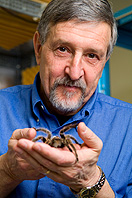News
Noteworthy UB inventions from 2011
-
 Print
Print -
 Comments
Comments
-

Frederick Sachs with his pet tarantula, Rosie. Sachs stumbled onto GsMTx4 whild doing a blind screen of arachnid venoms. Photo: DOUGLAS LEVERE
UB researchers racked up a diverse list of inventions in 2011, spanning fields from medical imaging to green energy.
As of mid-December, UB was issued 14 new U.S. patents and filed 43 provisional patent applications in 2011, according to the university’s Office of Science, Technology Transfer and Economic Outreach (STOR). Among other responsibilities, the office assists university researchers in identifying, protecting and licensing intellectual property.
Below are a few highlights from a year of invention at UB. In partnership with UB faculty, staff and students, STOR filed a provisional patent application, the precursor to a regular patent application, for each of the following innovations in 2011:
Personalized News: Novel software invented by UB computer scientists and engineers aims to help consumers explore the vast world of online news without having to manually search for information of interest. The software’s algorithms learn from users’ reading preferences, automatically providing a personalized reading experience.
Inventors: Smruthi Mukund, Venugopal Govindaraju, Anurag Bhardwaj and Achint O. Thomas
Smarter Windows: Materials that shift between being transparent and opaque to infrared light could one day form the basis of “smart windows” that reflect heat only on hot days. UB researchers have fine-tuned one such material, vanadium oxide, in novel ways that have caught the interest of a U.S. building products company that sees potential for vanadium oxide window coatings.
Inventors: Sarbajit Banerjee, Christopher J. Partridge and Luisa Whittaker
Treating Sickle Cell Anemia: GsMTx4 is a peptide that inhibits stretch-activated channels on cell membranes. Scientists in the School of Medicine and Biomedical Sciences previously demonstrated that the peptide may help prevent muscle damage caused by Duchenne Muscular Dystrophy. Now, the team has shown that GsMTx4 also may be beneficial to blood cells of sickle cell anemia patients.
Inventors: Frederick Sachs, Philip Gottlieb, Tom Suchyna, Seth L. Alper, David H. Vandorpe and Chang Xu
Safer Medical Imaging: UB researchers have crafted a new X-ray imaging system that emphasizes patient safety by prioritizing the primary region of interest of the body. The system greatly reduces the radiation dosage over most of the field of view outside the region of interest while providing the necessary high-quality, real-time image within the area of interest.
Inventors: Stephen Rudin and Daniel R. Bednarek
New Batteries: Esther Takeuchi, Greatbatch Professor of Advanced Power Sources, School of Engineering and Applied Sciences, has led a team of researchers in developing technology for a new class of batteries that employ low-cost materials.
Inventors: Esther Takeuchi, Kenneth J. Takeuchi and Amy Marschilok
Stapled Peptides: UB scientists previously devised ways of “stapling” peptides to prevent the peptides, which are used in many pharmaceuticals, from losing their shape and being degraded by proteolytic enzymes. Now, the researchers have used a protein to improve the cellular uptake of their stapled peptides. This intellectual property is part of a portfolio that researchers are developing for commercialization.
Inventors: Qing Lin, Avinash Muppidi and Hong-Gang Wang
Better Solar: With military colleagues, UB researchers have shown that embedding charged quantum dots into solar cells can greatly improve efficiency. The charged dots increase the lifetime of photoelectrons and enable solar cells to harvest infrared light in addition to visible light.
Inventors: Andrei Sergeev, Vladimir Mitin, Nizami Vagidov, Kitt Reinhardt, Kimberly Sablon and John W. Little
Multispectral Imaging: UB researchers have developed a multispectral imaging technology that uses photopolymer reflection grating filters to identify “true color.” This portable, or hand-held technology, can be used in remote sensing for military and defense applications; bio-imaging; and environmental, agricultural, food safety and climate monitoring.
Inventors: Qiaoqiang Gan, Alexander N. Cartwright, Ke Liu and Huina Xu

Reader Comments